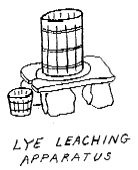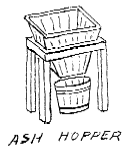Making lye from wood ash
Lye made from wood ash is
potassium hydroxide, not sodium hydroxide -- there's 10 times as much
potassium as sodium in wood ash.
The process makes lye water. If you boiled off all the water you could use
it as the catalyst to make biodiesel, but you'd need more accurate pH
measures than those listed below. The usual pH meter or litmus papers would
do. See also
Natural test papers.
Making the lye
Drill a lot of holes in the
bottom of a small wooden barrel, make sure it's waterproof before you drill
the holes!
Stand the barrel on blocks leaving space beneath the barrel for a container.
Use a waterproof wood or glass container. Lye can burn through some metals.
Put a layer of gravel in the bottom of the barrel over the holes, then put a
layer of straw over the gravel. Fill the rest of the barrel with hardwood
ash (NOTE: hardwood -- NOT softwood), leaving a couple of inches at the top
clear. Then pour rainwater into the barrel. After a long time the water in
the barrel will start to drip into the container. Leave it until it stops,
then replace the container with another in case of odd drips.
Use an old iron pot, or a steel pan (One you will not be using for anything
else!). Boil the liquid until it is so concentrated that a fresh egg (still
in it's shell please!) will float on top. Then destroy the egg. Remember to
take all precautions not the let the liquid touch your skin or clothing.
To test the strength of the lye you need a saturated solution of salt.
Dissolve chemical-free salt in a pint of water until no more salt will
dissolve. Take a stick and put a small weight on the end of it and float it
in a pint of the salty water. The weight will sink to the bottom, while the
top of the stick will float. Make a mark on the stick where it reaches the
water line. Then float the stick and weight in a pint of lye. The mark on
the stick will probably be above the water mark of the lye. If so, stir in
some more rainwater until the mark on the stick is in exactly the same place
it was in the salt water. You now have the correct distillation of lye for
making soap.
From "How to Make: SOAP"
http://www.oldcity.demon.co.uk/shez/m_make.html#make2
Making "Lye Water"
Soap making uses a caustic
solution known as "Lye Water".
When available, Caustic Soda is used. Here we will make Lye Water out of
certain wood ashes and "soft water".
1) White Ashes
Dried palm branches, dried out
banana peels, cocoa pods, kapok tree wood, oak wood, (or for really white
soap, apple tree wood) make the best lye ashes. Ordinary wood used in
cooking fires will do.
Whatever wood is used, it should be burned in a very hot fire to make very
white ashes.
When cold, these are stored in a covered plastic bucket or wooden barrel, or
stainless steel container. If these are not available, a clay pot-jar which
has been fired in a pottery making kiln (not just dried in the sun).
A wooden drum or barrel which has a tap at the right is best.
2) Soft Water
Water from a spring or from
showers of rain is called "soft water", because it does not have metallic or
acidic chemicals in it.
This makes it useful for soap making, as there are no other chemicals in it
which would get in the way of making soap.
"Ordinary" bore, well, or river water can be used for making soap, but this
will sometimes need to have a "washing soda" or "baking soda" added to it.
Otherwise some of the chemicals in the water will get in the way of making
the soap.
If you are using "ordinary" water and you want to test it to see if some
soda needs to be added, simply try to make soap bubble up (foam) in it.
If the soap easily foams up, the water is probably ok as it is.
If not, try adding a little bit of soda at a time stirring it to make it
disappear, until the water will foam the soap up.
Then add the same amount of soda to the same amounts of the water that you
wish to use to make the soap. For example, if you were testing a 1/4 (a
quarter) of a bucket of water, and you ended up needing 1/8 (an eighth) of a
cup of soda, then you would need 4/8 ( or 1/2-half) a cup of soda for a full
bucket of "ordinary" water.
However you have got it, store the "soft water" in covered wooden, plastic,
or stainless steel buckets or containers. (Again, a clay-jar as described
above can be used if needed.)
"Safe" Containers
Any of the types of containers, buckets, barrels or jars described in the White Ashes or Soft Water sections are called "safe containers".
Making "Lye Water"
If you are going to use a
large barrel or drum to make the lye water in, and it has a tap or hole at
the right, place some kind of filter on the inside of the barrel around the
opening.
Fill the barrel with white ashes to about four inches (10 cm or 0.1 metre)
below the top.
Boil half (1/2) a bucket full of soft water (about 10 pints or six litres),
and pour over the ashes.
Slowly add more cold soft water until liquid drips out of the barrel. Close
the tap or block the hole.
Add more ashes to top the barrel up again, and more soft water. Do not add
so much water that the ashes swim.
Leave to stand for four or more hours (or overnight if you have the time).
Later pour the brownish lye water into a plastic or other "safe" container(s).
Then pour back through the ashes again. Let the lye water drip into "safe"
containers.
When the brown lye water stops coming out of the barrel, or ash container,
then pour four to five pints (2-1/2 to three litre) of soft water through
the ashes, collecting the lye which comes out in a separate "safe" container
(as this lye may be weaker than the first lot).
Repeat this using two to three pints (one to two litres) of soft water,
until no more brown liquid comes out of the ashes.
Either put the lye into "safe" bottles, or cover the "safe" containers which
it is in. Dig the ashes into the vegetable garden.
Lye Water Strength
If an egg or potato will float
just below halfway, or a chicken feather starts to dissolve in it, then the
lye water is at the right strength.
If the egg will not float, then the lye water could be boiled down if you
want it to be stronger.
If the egg seems to pop up too far, add a little bit of soft water (a cup at
a time) stirring the lye water, until the egg floats so that its head pops
up.
From Soap Making - Traditional Methods: Lye Rain Water Wood Ash
http://ourworld.compuserve.com/homepages/
paul_norman_3/SOAPMAKE.HTM
Make The Lye
In making soap the first
ingredient required was a liquid solution of potash commonly called lye.
 The
lye solution was obtained by placing wood ashes in a bottomless barrel set
on a stone slab with a groove and a lip carved in it. The stone in turn
rested on a pile of rocks. To prevent the ashes from getting in the solution
a layer of straw and small sticks was placed in the barrel then the ashes
were put on top. The lye was produced by slowly pouring water over the ashes
until a brownish liquid oozed out the bottom of the barrel. This solution of
potash lye was collected by allowing it to flow into the groove around the
stone slab and drip down into a clay vessel at the lip of the groove.
The
lye solution was obtained by placing wood ashes in a bottomless barrel set
on a stone slab with a groove and a lip carved in it. The stone in turn
rested on a pile of rocks. To prevent the ashes from getting in the solution
a layer of straw and small sticks was placed in the barrel then the ashes
were put on top. The lye was produced by slowly pouring water over the ashes
until a brownish liquid oozed out the bottom of the barrel. This solution of
potash lye was collected by allowing it to flow into the groove around the
stone slab and drip down into a clay vessel at the lip of the groove.

Some colonists used an ash hopper for the making of lye instead of the
barrel method. The ash hopper, was kept in a shed to protect the ashes from
being leached unintentionally by a rain fall. Ashes were added periodically
and water was poured over at intervals to insure a continuous supply of lye.
The lye dripped into a collecting vessel located beneath the hopper.
The hardest part was in determining if the lye was of the correct strength,
as we have said. In order to learn this, the soap maker floated either a
potato or an egg in the lye. If the object floated with a specified amount
of its surface above the lye solution, the lye was declared fit for soap
making. Most of the colonists felt that lye of the correct strength would
float a potato or an egg with an area the size of a ninepence (about the
size of a modern quarter) above the surface. To make a weak lye stronger,
the solution could either be boiled down more or the lye solution could be
poured through a new batch of ashes. To make a solution weaker, water was
added.
From Colonial Soap Making: Its History and Techniques -- The Soap Factory
http://www.alcasoft.com/soapfact/history.html
"When a fresh egg floats with a nickel-sized to quarter-sized area above the
surface, the liquor is ready for soap making." -- Homestead mailing list.
Nickel = 2 cm diameter
Quarter = 2.5 cm diameter
At the turn of the last century lye was obtained by leaching water through
wood ashes. At best, the concentration of potassium hydroxide in the
resulting lye water was always questionable. My grandmother said that she
could tell if the lye water was the right strength by using the wing feather
pulled from her favorite goose. She would pour the lye water into a 30
gallon cooking pot and heat the solution. Next she would touch the feather
to the heating lye. If the feather dissolved, the lye was strong enough to
dissolve pig fat.
-- Soap Making Today
Originally published at: http://journeytoforever.org/biodiesel_ashlye.html
If you try this, we'd be very interested to know the results -- please contact us.